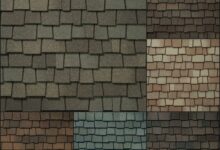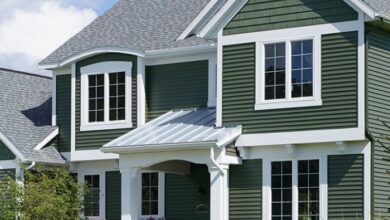T1-11 Siding A Complete Guide
T 1 11 siding – T1-11 siding, known for its distinctive vertical grooves, offers a classic and versatile look for homes. This durable wood siding, manufactured from various grades of wood, provides a cost-effective alternative to other cladding materials. But is it the right choice for your project? This comprehensive guide dives deep into the world of T1-11 siding, covering everything from installation and maintenance to design considerations and cost analysis, helping you make an informed decision.
We’ll explore the different types of T1-11 available, examining their thicknesses, textures, and price points. We’ll then walk you through the installation process, detailing the necessary tools, techniques for cutting around windows and doors, and essential maintenance practices. Finally, we’ll address common problems and their solutions, ensuring you’re well-equipped to handle any challenges that may arise.
Understanding “T1-11 Siding”
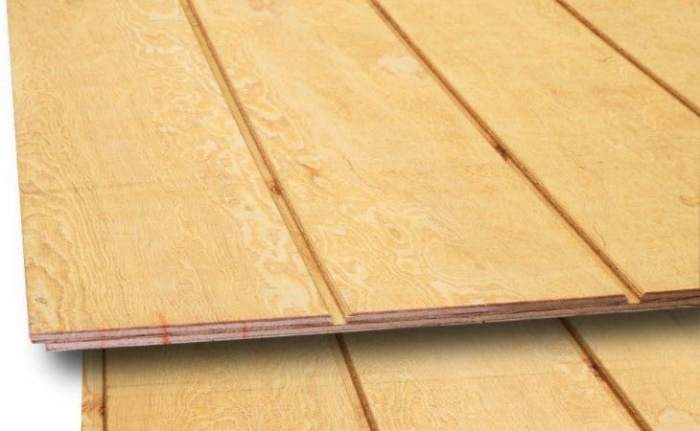
T1-11 siding, a popular choice for exterior cladding, offers a blend of affordability and durability. Its distinctive vertical grooves provide a classic, textured look, making it a versatile option for various architectural styles. Understanding its manufacturing process, available grades, and comparative lifespan is crucial for making informed decisions during a home renovation or new construction project.
T1-11 Siding Manufacturing
T1-11 siding is manufactured from wood, typically a combination of softwoods like spruce, pine, or fir. The wood is first processed into long, rectangular planks. These planks are then run through a machine that cuts the characteristic vertical grooves. This grooving process not only enhances the aesthetic appeal but also increases the siding’s structural rigidity and helps it resist warping and cupping. Finally, the planks are treated with preservatives to protect against rot, insects, and moisture damage. The specific preservative treatment varies depending on the manufacturer and the intended application. Some manufacturers offer options for fire-retardant treatments as well.
Grades and Types of T1-11 Siding
Several grades of T1-11 siding exist, reflecting variations in knot density and overall appearance. Higher grades generally feature fewer knots and a smoother surface, resulting in a more premium aesthetic. Common grades include “Prime,” which boasts the highest quality with minimal imperfections, and “Standard,” which may exhibit more knots and minor blemishes. Beyond grade, T1-11 is also available in different thicknesses, impacting both its cost and durability. Thicker siding naturally offers greater resistance to damage and provides improved insulation. Texture also varies, with some manufacturers offering a smoother finish while others maintain a more pronounced, deeply grooved texture.
Lifespan and Durability Compared to Other Materials
T1-11 siding, with proper maintenance and treatment, boasts a respectable lifespan. While the exact duration depends on factors like climate, exposure, and maintenance practices, a well-maintained T1-11 installation can last for 20-30 years or more. Compared to other siding materials, T1-11 offers a moderate lifespan. Vinyl siding generally lasts longer, often exceeding 30 years, while fiber cement siding can last even longer, potentially reaching 50 years or more. However, T1-11 offers a more natural aesthetic than vinyl and is often more affordable than fiber cement. Wood siding, while offering a similar aesthetic to T1-11, may require more frequent maintenance and may have a shorter lifespan depending on the type of wood and the climate.
Advantages and Disadvantages of T1-11 Siding
T1-11 siding presents several advantages, including its relatively low cost compared to other options like fiber cement or brick. Its ease of installation makes it a popular choice for DIY projects. The natural wood aesthetic provides a classic look, blending well with various architectural styles. However, disadvantages include its susceptibility to moisture damage if not properly treated and maintained. Regular painting or staining is usually required to prolong its lifespan and protect it from the elements. Compared to materials like vinyl or fiber cement, T1-11 requires more maintenance to retain its appearance and structural integrity.
Comparison of T1-11 Siding Options
| Thickness (inches) | Texture | Cost (per square foot – approximate) | Estimated Lifespan (years) |
|---|---|---|---|
| 0.25 | Deep Groove | $1.50 – $2.50 | 20-25 |
| 0.375 | Deep Groove | $2.00 – $3.00 | 25-30 |
| 0.5 | Smooth | $2.50 – $3.50 | 30+ |
| 0.5 | Deep Groove | $3.00 – $4.00 | 30+ |
*Note: Costs are approximate and can vary significantly based on location, retailer, and grade of material. Lifespan estimates assume proper installation and regular maintenance.
Installation and Maintenance of T1-11 Siding
T1-11 siding, known for its durability and classic look, requires careful installation for optimal performance and longevity. Proper preparation and technique are crucial to ensure a watertight and aesthetically pleasing finish that will stand the test of time. This section details the steps involved in installing T1-11 siding, best practices for surface preparation, necessary tools and materials, and crucial techniques for working around windows and doors. Finally, we’ll cover essential maintenance tasks to keep your T1-11 siding looking its best for years to come.
Surface Preparation for T1-11 Siding Installation
Before installing T1-11 siding, thorough surface preparation is paramount. This involves ensuring a clean, dry, and level substrate. Any existing siding must be removed completely, and any damaged sheathing or framing needs to be repaired or replaced. Inspect the wall for any signs of rot, insect infestation, or water damage. Address these issues before proceeding. A level surface is essential for proper alignment of the siding; use shims where necessary to achieve a consistent plane. Finally, treat the surface with a suitable primer to improve adhesion and protect against moisture. This preparation ensures the siding adheres properly and prevents future problems.
Tools and Materials for T1-11 Siding Installation, T 1 11 siding
A successful T1-11 siding installation relies on having the right tools and materials at hand. Essential tools include a measuring tape, level, circular saw with a fine-tooth blade, safety glasses, work gloves, hammer, nail gun (optional but highly recommended for efficiency), and a pry bar for removing old siding. Materials required include T1-11 siding panels, appropriate nails or staples (galvanized for exterior use), flashing tape, caulk, and house wrap (if not already installed). Having all these materials readily available streamlines the installation process and ensures a smooth, efficient workflow.
Installing T1-11 Siding: A Step-by-Step Guide
The installation process begins with establishing a level starting point. This is usually at the bottom of the wall, ensuring a straight and even appearance. The first course of siding is installed, using appropriate spacing and ensuring proper alignment. Subsequent courses are then added, overlapping the previous course according to manufacturer’s instructions, typically 1/2 inch to 3/4 inch. Nails should be driven straight and flush, avoiding damage to the siding. Always refer to the manufacturer’s specifications for nail placement and spacing. Remember to maintain consistent spacing between the siding panels for a uniform look. Proper installation prevents issues like water damage and ensures the longevity of the siding.
Cutting and Fitting T1-11 Siding Around Windows and Doors
Cutting and fitting T1-11 siding around windows and doors requires precision and attention to detail. Accurate measurements are essential. Use a sharp blade to ensure clean cuts, avoiding splintering. Remember to account for expansion and contraction of the wood. Flashing tape should be used around all window and door openings to create a waterproof seal. Proper caulking is also essential to prevent water intrusion. These steps ensure that the siding is correctly installed around openings, preventing moisture from entering the building.
Maintenance of T1-11 Siding: A Checklist
Regular maintenance is key to extending the lifespan of your T1-11 siding.
- Inspect the siding regularly for any signs of damage, such as cracks, rot, or insect infestation.
- Clean the siding periodically using a pressure washer or garden hose to remove dirt, debris, and mildew.
- Repair any damaged sections promptly to prevent further deterioration.
- Re-caulk around windows and doors as needed to maintain a watertight seal.
- Apply a fresh coat of paint or stain every few years to protect the siding from the elements and maintain its appearance.
Regular maintenance ensures your T1-11 siding remains in excellent condition for many years, saving you on potential repair costs.
Design Considerations and Applications
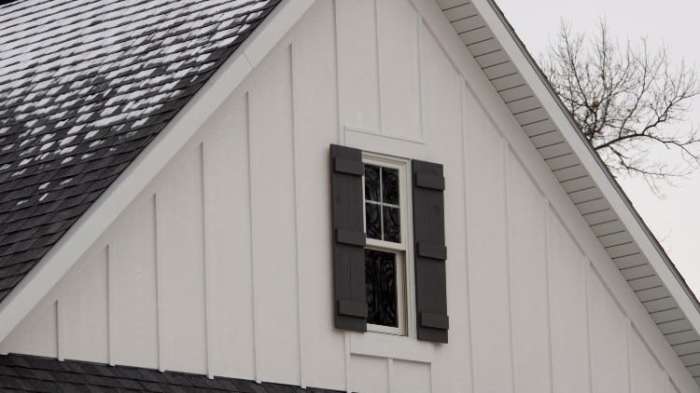
T1-11 siding, with its distinctive vertical grooves and versatile nature, offers a wide range of design possibilities. Understanding its aesthetic qualities and limitations is crucial for successful integration into various architectural styles and climates. This section explores design considerations and appropriate applications for T1-11 siding, highlighting its strengths and comparing it to alternative cladding materials.
Design Styles and Architectural Integration
T1-11 siding’s inherent texture lends itself to a variety of design aesthetics. Its rustic charm makes it a natural fit for farmhouse, craftsman, and cabin styles. The clean lines and vertical orientation can also be incorporated into contemporary designs, creating a modern farmhouse aesthetic or a minimalist feel when paired with sleek windows and metal accents. In traditional styles, T1-11 can be used to create a classic, slightly weathered look, especially when stained a dark, natural color. The versatility of the material allows for a range of finishes, from natural wood tones to bold, vibrant colors, broadening its appeal across diverse architectural styles.
Climate Considerations for T1-11 Siding
The suitability of T1-11 siding depends heavily on the climate. In regions with high humidity or frequent rainfall, proper sealing and maintenance are essential to prevent moisture damage. Regularly inspecting and repainting or restaining the siding helps extend its lifespan in these conditions. In drier climates, T1-11 can withstand harsh sun exposure with minimal maintenance, provided it’s properly treated and protected from excessive UV rays. In colder climates, T1-11’s ability to expand and contract with temperature changes should be considered, ensuring proper installation to avoid cracking or warping.
Aesthetic Comparison with Other Cladding Materials
Compared to other cladding materials, T1-11 offers a unique balance of cost-effectiveness and aesthetic appeal. While vinyl siding is cheaper and requires less maintenance, it lacks the natural texture and character of T1-11. Brick and stone offer superior durability but are significantly more expensive and heavier. Fiber cement siding provides a durable alternative, but its smooth finish contrasts with the textured look of T1-11. Ultimately, the choice depends on budget, desired aesthetic, and climate considerations.
Visual Representation of a House with T1-11 Siding
Imagine a two-story house with a gently sloping roof. The exterior walls are clad in T1-11 siding, stained a rich, dark brown. Large, multi-paned windows flank a central, covered porch, featuring a sturdy wooden railing. The porch is framed by exposed beams, matching the dark brown of the siding. A stone foundation provides a contrasting texture and color, grounding the structure. The landscaping includes mature trees and well-maintained shrubs, complementing the rustic, yet refined, design. The overall effect is a blend of modern and traditional elements, showcasing the versatility of T1-11 siding in creating a visually appealing and cohesive exterior.
Cost and Sustainability Aspects
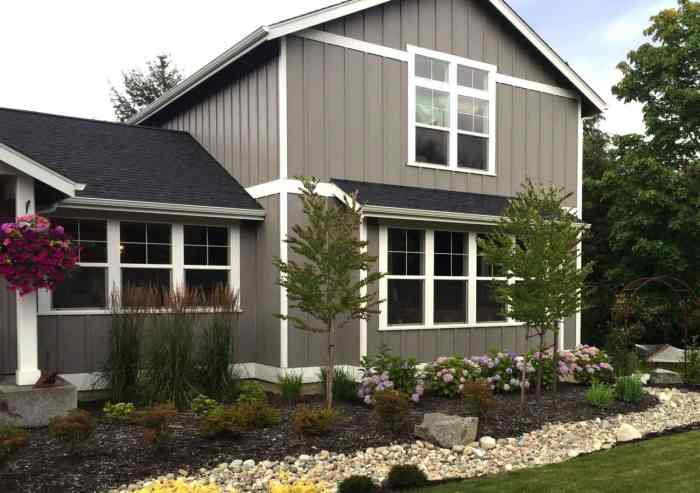
T1-11 siding presents a compelling option for homeowners seeking a durable and aesthetically pleasing exterior cladding. However, a complete understanding requires a thorough examination of its cost implications and environmental footprint. This section delves into the financial and sustainability aspects of choosing T1-11, allowing you to make an informed decision.
Pricing Breakdown of T1-11 Siding
The cost of T1-11 siding is influenced by several factors, primarily the material’s quality, the project’s size, and regional pricing variations. The price per square foot of T1-11 typically ranges from $2 to $5, excluding installation. Labor costs can significantly add to the overall expense, averaging between $3 and $8 per square foot depending on the complexity of the project and the installer’s rates. For example, a 1,000 square foot project could range from $5,000 to $13,000, encompassing both materials and labor. This price can fluctuate based on geographic location; labor rates are generally higher in urban areas compared to rural settings. Furthermore, the need for additional materials, such as flashing and trim, should also be factored into the budget.
Environmental Impact of T1-11 Siding
T1-11 siding, being primarily composed of wood, carries an inherent environmental impact. The manufacturing process involves harvesting timber, which contributes to deforestation if not sourced sustainably. Additionally, the production process consumes energy and generates waste. At the end of its lifespan, improper disposal of T1-11 siding can lead to landfill accumulation. However, responsible sourcing from certified sustainable forests mitigates some of these negative impacts. Furthermore, proper recycling or repurposing of the material after removal significantly reduces its environmental footprint.
Long-Term Cost-Effectiveness Compared to Alternatives
Comparing T1-11 to other siding materials reveals its long-term cost-effectiveness. While the initial investment might be comparable to vinyl or fiber cement, T1-11’s durability and relatively low maintenance needs translate to lower long-term costs. Vinyl siding, for example, may require replacement more frequently due to its susceptibility to damage, leading to higher overall costs over its lifetime. Fiber cement, while durable, often carries a higher initial cost. The longevity of T1-11, potentially lasting decades with proper maintenance, makes it a competitive choice in the long run. The need for fewer repairs and replacements offsets the initial investment, resulting in a favorable cost-benefit ratio over time.
Sustainable and Recycled T1-11 Siding Options
While standard T1-11 siding is not inherently recycled, increasing awareness of sustainable practices has led to a greater emphasis on responsible sourcing. Look for T1-11 siding certified by organizations like the Forest Stewardship Council (FSC), ensuring the wood comes from sustainably managed forests. While fully recycled T1-11 is not widely available, the focus on responsible forestry practices is a crucial step towards minimizing the environmental impact. Furthermore, repurposing removed T1-11 siding for other applications, such as fencing or garden structures, is a viable option to reduce waste.
Budgeting Factors for a T1-11 Siding Project
Careful budgeting is essential for a successful T1-11 siding project. Consider these factors:
- Material Costs: The price per square foot varies depending on the quality and thickness of the siding.
- Labor Costs: Professional installation significantly impacts the overall cost.
- Permitting Fees: Local regulations may require permits, adding to the expenses.
- Underlayment and Accessories: Flashing, trim, and other accessories add to the material cost.
- Waste Removal: Proper disposal of old siding and construction debris incurs additional costs.
- Contingency Fund: A buffer for unforeseen expenses is crucial.
Troubleshooting and Repair: T 1 11 Siding
T1-11 siding, while durable, isn’t impervious to damage. Understanding common problems and effective repair techniques is crucial for maintaining its longevity and aesthetic appeal. This section details troubleshooting steps and repair methods for various issues, ensuring your T1-11 siding remains a valuable asset to your property.
Common T1-11 Siding Problems
Several factors contribute to T1-11 siding damage. These range from environmental exposure to improper installation. Recognizing these issues early allows for timely intervention and prevents more extensive repairs.
| Problem | Solution |
|---|---|
| Water Damage (Swelling, Rot) | Identify and repair the source of the leak. Remove affected siding sections, ensuring you cut back to sound wood. Replace with new T1-11 siding, ensuring proper flashing and caulking. Treat the surrounding area with a wood preservative. |
| Insect Infestation (Termites, Carpenter Ants) | Inspect for signs of infestation, including tunnels, frass (insect droppings), and weakened wood. Treat the affected area with a registered insecticide following label instructions. Replace severely damaged sections of siding. Consider preventative measures like termite barriers. |
| Cracks and Splits | Minor cracks can be filled with exterior-grade wood filler, ensuring a smooth finish after drying. Larger cracks or splits necessitate replacing the damaged section of siding. |
| Paint Failure (Peeling, Blistering) | Proper surface preparation is key. Scrape away loose paint, sand the surface smooth, and prime before repainting with an exterior-grade paint suitable for wood siding. |
| Loose or Damaged Fasteners | Tighten loose nails or screws. Replace damaged fasteners with corrosion-resistant alternatives. If the siding is significantly loose, it may require complete replacement. |
Repairing Damaged T1-11 Siding
Repairing damaged T1-11 siding requires precision and attention to detail. The goal is to seamlessly integrate the repair with the existing siding, maintaining the overall aesthetic.
Replacing a damaged section typically involves these steps:
- Carefully remove the damaged siding section, cutting back to sound wood. This ensures the replacement integrates properly.
- Measure the area to determine the size of the replacement piece. Ensure accurate measurements to avoid gaps or overlaps.
- Cut a new piece of T1-11 siding to the exact dimensions, using a sharp utility knife or circular saw.
- Apply a bead of exterior-grade caulk to the back of the new siding piece before installation.
- Secure the new siding section using corrosion-resistant nails or screws, spacing them evenly to prevent warping.
- Caulk all seams and joints to prevent water intrusion.
- Prime and paint the repaired area to match the existing siding.
Addressing Water Damage and Rot
Water damage is a significant threat to T1-11 siding, leading to rot and structural compromise. Early detection and prompt action are crucial. The process involves identifying the source of the leak (e.g., damaged flashing, faulty gutters), removing the affected siding, treating the underlying wood with a wood preservative, and replacing the damaged sections with new T1-11 siding, ensuring proper sealing and flashing to prevent future water damage. In cases of severe rot, it may be necessary to replace a larger section of siding or even underlying sheathing.
From its rustic charm to its surprisingly modern applications, T1-11 siding presents a compelling option for homeowners seeking a balance of aesthetics, durability, and cost-effectiveness. By understanding the nuances of its various grades, installation requirements, and long-term maintenance needs, you can confidently determine if T1-11 siding is the ideal solution for your next home improvement project. Remember to factor in the total cost, including materials and labor, and consider the environmental impact when making your final decision. With careful planning and execution, T1-11 siding can enhance your home’s curb appeal for years to come.
Helpful Answers
What is the average lifespan of T1-11 siding?
With proper maintenance, T1-11 siding can last 30-50 years, though this depends on factors like climate and the quality of the wood.
Can T1-11 siding be painted?
Yes, T1-11 siding can be painted, but it’s crucial to use a high-quality exterior paint designed for wood siding. Proper preparation, including priming, is essential for a long-lasting finish.
Is T1-11 siding fire-resistant?
T1-11 siding is not inherently fire-resistant. However, its fire rating can be improved with the application of fire-retardant treatments.
How do I clean T1-11 siding?
Regular cleaning with a mild detergent and water, followed by rinsing, is sufficient. For stubborn stains, use a pressure washer cautiously to avoid damaging the siding.
Is T1-11 siding suitable for all climates?
While durable, T1-11 siding is more susceptible to moisture damage in excessively humid or rainy climates. Proper sealing and maintenance are crucial in these conditions.





